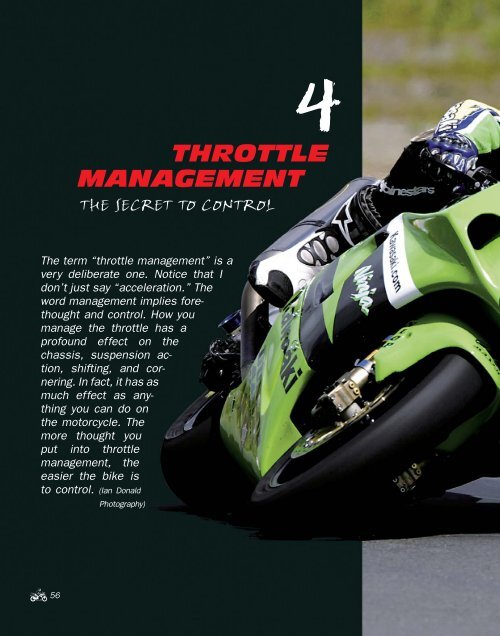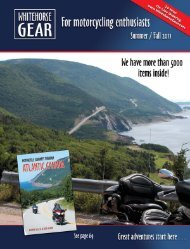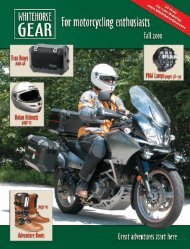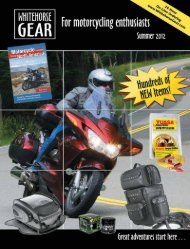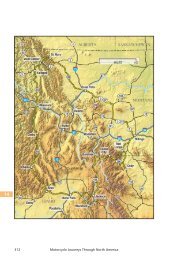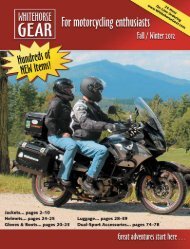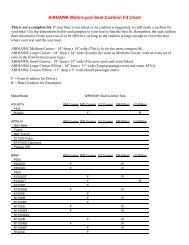THROTTLE MANAGEMENT - Whitehorse Gear
THROTTLE MANAGEMENT - Whitehorse Gear
THROTTLE MANAGEMENT - Whitehorse Gear
- No tags were found...
You also want an ePaper? Increase the reach of your titles
YUMPU automatically turns print PDFs into web optimized ePapers that Google loves.
<strong>THROTTLE</strong><strong>MANAGEMENT</strong>THE SECRET TO CONTROLThe term “throttle management” is avery deliberate one. Notice that Idon’t just say “acceleration.” Theword management implies forethoughtand control. How youmanage the throttle has aprofound effect on thechassis, suspension action,shifting, and cornering.In fact, it has asmuch effect as anythingyou can do onthe motorcycle. Themore thought youput into throttlemanagement, theeasier the bike isto control. (Ian DonaldPhotography)56
SMOOTH RIDING: THE PRIDMORE WAYBENEFITS OF <strong>THROTTLE</strong><strong>MANAGEMENT</strong>. No matterwhat size bike you ride,and whether you’re in a 100mph sweeper or going tothe corner store, the throttleis your guidance mechanism,affecting everythingfrom suspension action tocornering line. (Photo courtesyAmerican Honda MotorCo., Inc.)roblem is, most people’s approach to thethrottle has nothing to do with management.They just want to whack it open or snap it shut.This can get you into a lot of trouble—especiallywith today’s more powerful bikes.Good throttle management can help youachieve better cornering lines, settle and stabilizeyour suspension, and help get you out of a hazardoussituation. The potential dividends arehuge—and so is the potential fun factor.THE MAGIC OF RPMSYou’ve heard me say it before, but it bears repeating:rpms are your friend. This is one of thebasic corollaries of throttle management, and itwill pay dividends that you won’t believe.For the sake of instruction, let’s look at hownot to do it. Say you’re in a corner at about 2,000rpm. Here’s what’s happening with the dynamicsof the bike: First, when you try to accelerate inmid-corner, the bike simply won’t respond. Theengine is not in its power range. Second, the bikewill not hold the desirable smooth line. Third,suspension action will tend to be unresponsivebecause it’s near the bottom of its travel. Becausethe bike is “squatting” in this way, ground clearancewill be reduced. Weight distribution is alsoaltered, with an inordinate amount on the frontand not enough on the rear.Now let’s look at how things are changedwith ample rpms. First, you have power at yourcommand for proper corner entry and exitspeeds and anything you might encountermid-corner. Next, by simply rolling the throttleon or off, you can widen or tighten your line inminute increments.Keeping on the gas in the proper rpm rangealso lifts the bike slightly, putting it in the middleof its suspension range and increasing groundclearance. This occurs because the application oftorque to the drive train (chain or shaft) causesthe rear end to rise. Lastly, weight is distributed58
4: Throttle Managementevenly between the front and rear tires, for optimumtraction. I bet you didn’t know that rpmscould do all that!Whether you are riding a 500cc or a 1000ccbike, and whether you are running an errand,doing a 500-mile day, or riding on the track,the throttle is your guidance mechanism. It affectseverything from cornering line, to suspensionactivity, to weight bias—and ofcourse, to speed.What does it mean to use ample rpms? With amodern four-cylinder, I tend to run between6,000 and 8,000 on the street for normal riding.On the track, and for spirited riding on a twistyroad, I use 8,000–12,000 rpm. For a pushrodtwin such as a BMW, I recommend using4,000–6,000 rpm, and for a Ducati V-twin, it’s6,000–8,000 rpm.BEGIN AT THE BEGINNING:HOW TO GRIP THE <strong>THROTTLE</strong>To grip the throttle for optimum control, I recommendyou let the first and second fingers “float”over the front brake lever, and wrap the third andfourth fingers around the grip. This works well formost people, but it isn’t etched in stone—yourhand or grip size may dictate a variation.Orient your hand on the grip in a way that allowsquick changes. On most modern bikes, youneed only a quarter-turn of the throttle to take theengine through its ideal rev range. (Older bikesmay require a bigger fistful—or two.)When in the middle of this range, and whilesitting comfortably in the saddle, your wristshould be relatively straight. You shouldn’t haveto pick your wrist up excessively, or point yourfingers down. Use only enough grip pressure toprevent slippage. Relax, but be firm.Don’t allow your bike to develop slop in thethrottle cable, which can make your throttlemanagement jerky. On most bikes it just takes acouple of small wrenches to remove the play atthe adjustment barrel where it exits the twistgrip.You want just a fraction of freeplay.After making this adjustment, be sure to twistthe handlebar from side to side with the engine atidle to ensure there’s no rise in rpms. If this occurs,the cable is constricted somewhere—a potentiallydangerous situation.HOW TO GRIP THE <strong>THROTTLE</strong> FOR OPTIMUM CONTROL.Rest the first and second fingers on the brake, and wrap thethird and fourth around the grip.<strong>THROTTLE</strong> <strong>MANAGEMENT</strong>AND CORNERINGDid you know that throttle management offersdirectional control in a corner? It’s as simple asthis: Close the throttle to tighten your line (comeinto the inside of the corner), and roll on thethrottle to push yourself to the outside.How does this work? Rolling off the throttletends to compress the front suspension, reducefork rake (quickening steering), and induce leanangle. Applying more throttle tends to arrest leanangle and straighten the bike slightly. Both ofthese changes affect your line in the corner.Most people don’t realize they can “steer”with the throttle. And it’s not just for racers. Itworks on any type of motorcycle—cruiser orsportbike—and in any corner.With the right rpms, and using fine throttle increments,this will enable you to cornersmoothly at 70–100-plus mph. Obviously, atthese speeds, control is critical. Don’t snap thethrottle shut or whack it open. We’re talkingabout throttle “management,” remember?DOWNHILL CORNERS, TOO!People ask me, “How can I use high rpms to negotiatea downhill corner? Won’t I go too fastand run off the road?”The answer is no! And the best proof I canthink of is the legendary Corkscrew at LagunaSeca Raceway in California. This piece of track59
LEARNING THE HARD WAYANATOMYOFACRASHI can hardly remember the first fouror five years of my street riding, becauseI wasn’t even thinking. I wasjust riding—out of control. All thischanged abruptly one day in 1965.At the time we used to race on anold airfield track at Cotati, north ofSan Francisco. As with many venuesback then, it was never meantto be a racetrack. The pavementwas very rough, with plenty of potholes,grass tufts coming upthrough seams, and no safety measuresto speak of. This was normalfor the day.I was running second in the250cc race, riding a single-cylinderGreeves Silverstone—a model affectionatelyknown as the “Gravestone.”I was chasing my perennialchallenger, the Japanese rider HaruKoshino, who was riding the highlytuned and fast Suzuki 12510-speed twin. My Greeves had potential,but little chance of stayingwith the factory bike—despite thedisplacement advantage. I was overmy head from the start.But who can tell a racer hedoesn’t have a chance? With twolaps to go, I had fought my way tosecond place. It is at this point thattime slows for me. I see myself enteringa left-hander very quickly. As Itilt the bike in abruptly, the expansionchamber touches down. Predictably,the bike launches me into ahighside. In an instant, I am airborne.What happens next is lost to me,but is later related by bystanders. Iam lying in the tall grass surroundingthe racetrack, inert and lifeless.Someone watching from the airporttower summons help. An Armymedic arrives and pulls my tongueout of my throat to keep me fromsuffocating. I am transported to thehospital, incoherent. The only thingI remember is telling the ambulancedriver, “You’re my friend! You’reErnie!” Ernie Caesar was my sidecarpassenger in those days. I wasreally out of it.The next thing I remember is anurse is cutting off my leathers.“No!” I tell her. My thoughts are notyet focused on my injuries, but onsaving the expensive, borrowedsuit. Typical racer!Eventually, I learn the full extentof my injuries: a double compoundfracture, three broken ribs, a brokenclavicle, and a skull fracture whichI’ve just got to stop doingthese suspension checkswhile riding! Ouch. Racerstalk about “finding theedge.” Well, I’ve found itmany times in my career—and gone over to theother side on more than afew occasions. The importantthing is to learnfrom the experience. (Photocourtesy Reg Pridmore)60
Coming up through theranks in the ‘60s I used tocompete on 125s and 250s.I won a lot of races on thisBultaco 125, but it cost mea lot of skin. It revved to12,000 rpm, but would alsoseize in a heartbeat, sendingme head over heels fora hard landing! But racingit was great fun. (Photo courtesyReg Pridmore)causes me to bleed from the ear. Myfoot angles down off the table at anunnatural angle. My face is scrapedand angry looking, thanks to theminimalist, open-face helmet I usedback then. In short, I am a mess.I stay in the hospital seven days.When I am released, I have a castup to my crotch. Stainless steelstitches and Threadall (large piecesof steel threaded rod) have beenused to knit my bones together. (Ayear and a half later, as a fitting mementoto my crash, I use theThreadall as an oil tank mountingbolt for my kneeler sidecar!)My wife, who is in England on vacation,knows nothing of my accident.Friends take me to the Los Angeles airportto meet her. “Don’t be shocked,”they tell her as I am wheeled out frombehind a barrier at the airport. “Reghas had a little mishap.” Little, indeed.It is a year before I am riding again.Ironically, on my first solo ride, at thesametrack,Islideoffinthesamecorner.All I can think is, “Please don’t letmy leg be broken again!” Fortunatelyit is a lowside this time, and I am fine.Damn that corner!But something changed that day in1965, and remains changed to thisday. My recuperation provided plentyof time to think. Through it all, I becamedetermined to have a betterplan. I knew I could ride, and had theresults to prove it. But I needed abetter way of doing business. Thatbetter way involved lots of planning,control, and smoothness.As I replayed the crash in my mind,all I could think of was that I had beendelivering a bad message to the bike.My inputs were abrupt. After that, Istarted exerting better control overmy bike, my mechanical preparation,and everything about my racing andriding. Even more important, I developedan attitude of lifelong learningand improvement. Motorcycling, Irealized, was something I could bebetter at but never completelymaster. No one ever can.People sometimes ask mewhether I thought of quitting afterthat horrific crash. The truth is, Inever considered it. Racing meanttoo much to me then, as riding stilldoes now. But after that day in1965, something did change, andremains changed.Believe me, you don’t need to havethe same experience to undergo atransformation in your attitude andyour riding. Use mine instead. I giveit to you freely, without the steelwire, the Threadall, or the body cast.61
SMOOTH RIDING: THE PRIDMORE WAYDID YOU KNOW THAT <strong>THROTTLE</strong> <strong>MANAGEMENT</strong> OFFERS DIRECTIONALCONTROL IN A CORNER? It’s as simple as this: Close the throttle to tighten your line(come into the inside of the corner), and roll on the throttle to push yourselfto the outside. (Ian Donald Photography)62
4: Throttle Managementgoes left, then right, then left again in quicksuccession, while losing the equivalent height ofa three-story building. It can be frightening (butfun). It also illustrates how much control you canhave at speed while going downhill. It instills alot of confidence to discover that you can controla corner like this with the throttle “on.” Low gear(first or second, depending on the motorcycle)will hold you back nicely and still give you theacceleration you’re looking for on the exit.On most bikes, first gear through the Corkscrewwill have the motor working close to maximumrpms. What about it? You’re not going tohurt the bike. In fact, most modern bikes willhappily take you to redline—at which pointthey’ll shut off due to an electronic rev limiter.Whether on the road or track, don’t be afraid touse maximum rpms if that’s what it takes to negotiatea downhill corner or give you the controlyou need.<strong>THROTTLE</strong> <strong>MANAGEMENT</strong>AND SUSPENSIONThrottle management is closely linked to suspensionaction. You want to keep the suspension “active”through a corner. This means it’s in the middleof its travel, primed and ready to do business. I thinkof the bike as a boat that’s leaving a wake through acorner, rising slightly under acceleration.For a moment, imagine the reverse: you’re infourth gear, rolling off the throttle through a corner.The suspension is relaxed and asleep. Thebike—like a decelerating boat—is sinking slightly,reducing ground clearance and increasing the likelihoodthat you’ll touch hard parts. Control is reduced.It’s a potentially devastating situation.Don’t corner with the suspension asleep.Keep it active and awake by using high rpms.<strong>THROTTLE</strong> <strong>MANAGEMENT</strong>AND DOWNSHIFTINGThrottle management is critical for smoothdownshifts. The secret is to maintain the correctrpm—one that makes engine speed match rearwheel speed. You need to bring these two thingsinto harmony. Here’s how:1. Blip the throttle: If you’ve ever been to a raceor watched one on TV, you’re familiar with thisone. Racers “blip” the throttle quickly and<strong>THROTTLE</strong> <strong>MANAGEMENT</strong> IS CLOSELY LINKED TOSUSPENSION ACTION. You want to keep the suspension“active” through a corner. This meansit’s in the middle of its travel, primed and readyto do business.smoothly prior to each downshift. Raising therpms in this way gives the engine time to settleinto the proper range by the time they’veperformed their clutch and shift action. It bringsengine and rear wheel speeds back into harmony.2. Keep the throttle where it’s at: Another methodis to simply maintain the same rpm—hold thethrottle open and perform the downshift andclutch action with such lightning speed that theengine doesn’t have time to fall out of synchwith the rear wheel.Say I’m on the track, coming into a 150-plusmph corner, and I want to go from sixth to fifth.I’ll just leave the throttle right where it is and dropit into gear. I’m turning perhaps 11,000 rpm at thispoint, which is perfect. I just leave it right there.63
SMOOTH RIDING: THE PRIDMORE WAYCORKSCREW. At LagunaSeca Raceway the corkscrewgoes left, thenright, then left again inquick succession, whilelosing the equivalentheight of a three-storybuilding. It can be frightening(but fun). It also illustrateshow much controlyou can have at speedwhile going downhill. (IanDonald Photography)Both of these methods take practice and sensitivity—that’sthe art of throttle management.<strong>THROTTLE</strong> <strong>MANAGEMENT</strong>AND UPSHIFTINGAnytime you’re going up through the gears, themagic words are: Don’t procrastinate. In otherwords, don’t be so deliberate in your shifts thatyou allow the rpms to drop off. This can causethe back end to do terrible things—at the least, alittle chirp, and at the worst, a big slide. Makeyour upshifts quickly.It helps to visualize what’s happening in thegearbox—what’s driving the motorcycle. Thetransmission is engaged via “dogs”—metalprotrusions on the individual gears. To imaginethis, take both hands, fold your fingers at90 degrees, and interlock them. When thesedogs are fully engaged, it’s pretty hard to separatethem (short of breakage). This is whatdrives the motorcycle forward.To disengage them, you need to provide somerelief via the clutch and the throttle. If you don’tencourage this separation, they just won’t comeapart. By pulling in the clutch momentarily andeasing off the throttle, you release the tension,and allow the dogs to separate and re-engage.When people say, “The bike jumped out of gear,”what they mean is the dogs didn’t engage solidlyor they were worn and not holding well enough.To ensure engagement, when you back off thethrottle for just a fraction to make your upshift,keep your foot under the shifter and maintainslight pressure while releasing the clutch leveruntil you know the gear is fully engaged.You can also upshift without the clutch. I do itoften—especially on the track. You need to relievea little tension (you can’t do it with powerfully on). In the blink of an eye, back off thethrottle, make your gear selection, and get backon the throttle.USING THE <strong>THROTTLE</strong> TO GETOUT OF A BAD SITUATIONYou might not think that using high rpmswould be synonymous with safety—but it is.Good throttle management provides a crucialmargin of safety for you (and your passenger),especially when riding in town. By using alower gear and keeping the rpms up, you haveenough engine braking at your disposal to takecare of most of life’s little surprises, by merelyrolling off the throttle.Even a variation of a few hundred rpms canalter your speed significantly when the engine isoperating in its ideal power band. Low rpms donot provide sufficient engine braking, or theability to vary engine braking in fine increments.There are also instances when a burst ofpower is just what you need. If you’re running at64
6,000 rpm, you can frequently rocket out of abad situation, because the engine is in its powerband and ready to respond. To prove this, youneed only look at the horsepower graphs that accompanymost magazine motorcycle tests.Horsepower rises exponentially in the upperreaches of the rpm range. But if you’re at 2,000rpm, you’re stuck. The engine won’t give you thesame response.BREAKING TRACTIONWhat would you do if the back end broke tractionin a corner and “stepped out?” Most peoplewould snap the throttle shut. It’s a natural reaction.Unfortunately, it’s also the worst thing youcan do.Here’s another golden rule: When the back endbreaks free in a corner or under acceleration, tryto maintain the same rpms until things stabilize.People look at me like I’m crazy when I saythis—or they think I’m boasting. I’m not. Whenyou snap the throttle shut, chances are that theback end will hook up and regain traction tooquickly, leading to the most dreaded crash ofall: the highside. The bike pops straight up,ejecting the rider like a piece of toast. Not agood thing!I’ve had the back end step out more times thanI can remember, and I’ve always fared best bymaintaining rpms. Any racer will tell you thesame thing. This is just as valid on the streetwhen you encounter that small oil patch or pebblesin mid corner. Stay on the gas.Unfortunately, it’s not something you canpractice on the street (or want to). All you can dois condition yourself mentally. Tell yourself,time and time again, I will maintain rpms. Rehearsethe scenario on your regular rides. It’sworth practicing, because the real thing can bescary and have dire consequences—if you reactemotionally and make the wrong choice.The throttle has so much to offer—if you’llmake the effort to discover what it can do. Itmakes the bike more active, transforming it intosomething that’s alive, and provides a tremendousmeasure of control and safety. And it willgive you the biggest kick of your life.Here’s a throttle management drill that will help assess yoursmoothness. I used this drill a lot to help teach my son, Jason.Try it on a straight, isolated road (no traffic if possible). Try makingvery short shifts from second through fourth and back downwithout significantly changing your road speed. Stay between 40and 50 mph.There are two ways to approach this. One method is to notmove your throttle hand—just pull the clutch in about a third ofits travel and go up and down through the gears. The othermethod is to maintain your rpms as you upshift, but to blip thethrottle slightly as you come down through the gears.This drill will really help you assess your shifting and whetherit’s jerky. You need to coordinate the throttle and clutch, andshift in one instantaneous motion. The key is to monitor thethrottle—any variance will make the bike lurch or drag. The drillwill also help you evaluate whether you are “dumping” the clutch.It’s a family affair: Two successful racers, Jasonand Reg Pridmore, during a 1997 CLASS school.(Photo courtesy Reg Pridmore)65


